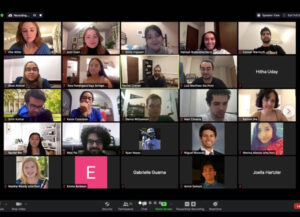New Campus Divestment Action in a Difficult, Socially Distant Era

 In early October, Cambridge University became the latest high-profile institution to declare its decision to divest from fossil fuels within the next ten years. Georgetown recently announced its intent to divest from public securities of fossil fuel companies by 2025 and to be fully divested from existing private investments in those companies by 2030. Amazing as these breakthroughs by noted campus administrations have been, such university commitments were brought about only after sustained pressure by student activists.
In early October, Cambridge University became the latest high-profile institution to declare its decision to divest from fossil fuels within the next ten years. Georgetown recently announced its intent to divest from public securities of fossil fuel companies by 2025 and to be fully divested from existing private investments in those companies by 2030. Amazing as these breakthroughs by noted campus administrations have been, such university commitments were brought about only after sustained pressure by student activists.
 As a climate activist at Vanderbilt University, I have witnessed first hand the passion and drive students feel about climate change and how divestment from fossil fuels is seen as integral to combatting this ever-growing crisis. Yet, despite their dedication, student activists can’t always prioritize their climate movement work on campus. Students have to juggle the financial burdens of their degrees, a semblance of social life, and, most importantly, the various challenges that come with being a student and social distance during a pandemic.
As a climate activist at Vanderbilt University, I have witnessed first hand the passion and drive students feel about climate change and how divestment from fossil fuels is seen as integral to combatting this ever-growing crisis. Yet, despite their dedication, student activists can’t always prioritize their climate movement work on campus. Students have to juggle the financial burdens of their degrees, a semblance of social life, and, most importantly, the various challenges that come with being a student and social distance during a pandemic.
That’s why student organizers have been innovative about how their movements are structured and, increasingly, are broadening their divestment networks beyond their college campuses.
“Once the majority of in-person events were cancelled, we leaned into organizing online – contacting administrators digitally and mobilizing widespread engagement with our university’s social media” says Kyle Rosenthal, a student organizer at Boston College.
Internet-based activism is so popular now that the “internet is not only perceived as a tool for assisting in activism, it is also used as a means of action in itself.” This has allowed for new techniques to emerge on the online arena such as virtual sit-ins, protests, hacking, hashtag campaigns, and online petitioning.
Social networking sites have been the crux of spreading these new tactics and are especially prevalent among younger activists who grew up in the digital age. According to a 2009 survey of 122 international digital activists, it was found that social networking sites are the most common tool used by respondents.
While most divestment campaigns manage an Instagram and Twitter account to share updates on their campus movement and recruit new members, behind the scenes divestment activists have been using social networking apps like Slack to connect with other movement leaders and plan intercollegiate events online.
Hannah Reynolds, a student at Princeton University, is one of the organizers of the school’s Discord group who helped plan Students For International Divestment (SID) Day, an 8-hour virtual climate strike encouraging universities to divest from the fossil fuel industry.
“A lot of times there are these climate strikes that are very focused on protests and the visibility of protests but right now that’s kind of difficult so it’s good to have a tangible goal that you’re calling for” says Reynolds about the virtual climate strike advocating for divestment in October.
 This event was primarily organized through Instagram, Facebook, and the Slack group which contains over 100 high school and college students across the world who are running divestment movements on their campus. SID Day featured over 20 speakers such as youth activist Isra Hirsi, author Bill McKibben, and Iowa State Senator Zach Wahls. The event was live streamed on YouTube and allowed for viewers to interact with panelists through Q&A.
This event was primarily organized through Instagram, Facebook, and the Slack group which contains over 100 high school and college students across the world who are running divestment movements on their campus. SID Day featured over 20 speakers such as youth activist Isra Hirsi, author Bill McKibben, and Iowa State Senator Zach Wahls. The event was live streamed on YouTube and allowed for viewers to interact with panelists through Q&A.
SID Day is only one event that student activists across the world worked together to host. Activists frequently use the Slack group to publicize their events, join in phone banking campaigns, and share graphics so that divestment coalitions at one university can promote action taken at other schools on their social media.
“In addition to sharing helpful resources, we have been a part of joint actions and letters with other students which has helped us get national press and [Boston College’s] attention to demonstrate how this is not an isolated movement.” says Rosenthal.
According to a press release shared by Rosenthal in Slack, legal action is currently being taken against Boston College over its fossil fuel investments. Linked within the press release is a list of signatories including James Edward Hansen, a professor who directs the Program on Climate Science, Awareness and Solutions of the Earth Institute at Columbia University. Such events and updates are commonly circulated within the Discord so that school coalitions can learn from other movements and replicate their actions.
“It also gave us a lot of support to see what other groups were going through and how they responded,” Rosenthal says regarding the importance of networking within the student divestment movement.
As online advocacy and coalitions have increased, movements are making real strides toward change on campus. According to Princeton divestment organizer Hannah Reynolds, “the administration has generally become much more open to discussion and collaboration with us, at least in terms of people who will make decisions on divestment.”
That doesn’t mean that everyone at the administrative level has been keen on supporting such student activism. “One of the biggest challenges of working with the administration,” Reynolds says, “is that they are sometimes more concerned with public image than actually doing what is in the best interest of the students and the world, which can lead them to be dismissive of our work and it can put supportive staff and administrators in a tough position.”
Despite the increase in student activist recruitment on campuses through online engagement, building coalitions with faculty and staff has proven more difficult. “There’s a general sense on campus that staff and admins who support divestment openly and join our efforts could lose their job or their reputation.” Reynolds explains, “When it comes to divestment, it’s my opinion that we cannot afford to restrict the conversation to just student activists because this is part of a much larger issue that will affect us all. She adds, “I wish there was more support from the administration for open dialogue within the University community on divestment”
The same cautious culture is mirrored across other colleges and universities. At Vanderbilt University, students have already passed support for divestment in the undergraduate student government and graduate student council, but they are still working to get support from the Faculty Senate.
“Getting student support has been easy but working with administration and faculty has proven more of a challenge”
—Shun Ahmed, a Vanderbilt divestment advocate.
Despite the struggles of college life during the pandemic, student activists are rapidly learning to adapt their advocacy to fit their needs and grow their movement. “We want to build a community of people having memorable college experiences and knowing they had a hand in making a difference on campus” said a divestment advocate at Vanderbilt. For those students, they recognize that no matter how daunting the challenges they face, action on climate cannot wait.
 Emily Irigoyen – Rachel Carson Council Fellow
Emily Irigoyen – Rachel Carson Council Fellow
Emily Irigoyen is a sophomore at Vanderbilt University pursuing a double major in Environmental Sociology and Spanish with a minor in Communications in Science and Technology. Her RCC Fellowship project is a fossil fuels divestment campaign for Vanderbilt and others in the Southeast Conference. [email protected]
![]() The Rachel Carson Council depends on tax-deductible gifts from concerned individuals like you. Please help if you can.
The Rachel Carson Council depends on tax-deductible gifts from concerned individuals like you. Please help if you can.
![]() Sign up here to receive the RCC E-News and other RCC newsletters, information and alerts.
Sign up here to receive the RCC E-News and other RCC newsletters, information and alerts.








